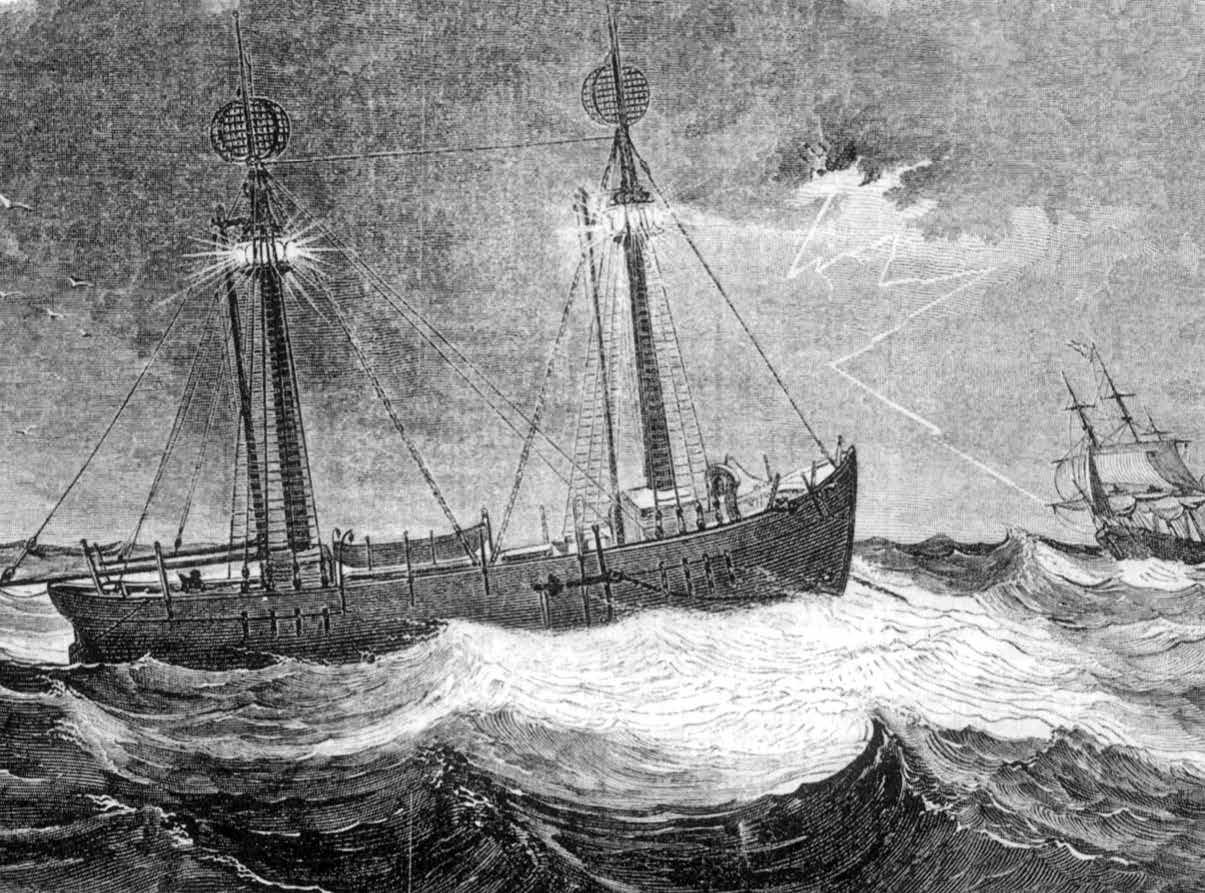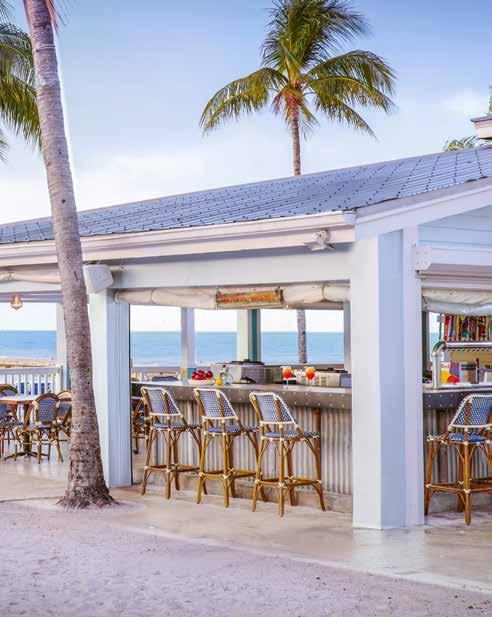
6 minute read
FLORIDA LIGHTSHIP DEALT WITH DIMNESS & DRUNKENNESS
CREW HAD RUN - INS WITH INDIANS
The Caesar was the first lightship to anchor at Turtle Harbor, where it worked to warn passing sailors of their proximity to the dangerous Carysfort Reef. The ship arrived in 1826 and only served a handful of years before it was condemned.
In 1829, Capt. John Whalton ordered the anchors brought in, employed the schooner’s sails, and set a course for Key West (and not for the first time). On May 26, 1829, the lightship Caesar arrived for repairs. After a survey of the ship was completed, the Collector of Customs, Mr. Pinkney, remarked that the Caesar’s timbers were “an entire mass of dry rot and fungus. I must say that there never was a grosser imposition practiced than by the contractor in this instance.” is an author, speaker, Florida Keys historian and Honorary Conch. His latest book, “Florida Keys History with Brad Bertelli, Volume 1,” shares fascinating glimpses into the rich and sometimes surprising histories of the Florida Keys.
The anchor, chains and sails were removed, and the hull was sold to a salvager named Fitzpatrick for $300. Congress allocated $20,000 for the construction of a replacement lightship. Named Florida, the lightship was anchored at Turtle Harbor and was first lit on Dec. 7, 1830. The ship served to warn passing mariners of their proximity to the large, shallow and treacherous Carysfort Reef.
Whalton transitioned from the Caesar to the Florida, where he remained until the day he died. Because food rations were somewhat limited aboard the lightship during its tenure at the reef, Whalton developed a garden on the shores of a cove on nearby Key Largo where he grew onions, tomatoes, melons and other fruits and vegetables to augment their general provisions. The area has since become known as Garden Cove.
On Oct. 5, 1836, as the second escalation of the Seminole War was ramping up, Whalton reported that Indians destroyed his garden. It was not the last time he would encounter the presence of Indians at the Key Largo garden. The following year, sometime in June, Whalton’s family sailed up from Key West to visit him on the Florida. The captain and four of his crew took their auxiliary boat to the cove for fresh fruit and vegetables, charcoal, or some combination of the two (depending on the account).
When they came ashore, the captain and his crew were greeted by a barrage of rifle fire from Indians who had watched them approach the cove from the garden. Four of the Florida’s men were struck, two mortally. Whalton and one crew member were shot dead on the beach. Two other crew members were wounded but were able to escape with the help of the lone member who escaped unharmed.
After Whalton’s death, a series of captains manned the helm of the Florida. One of the more colorful was Capt. Leonard Sistone, who abandoned his post one day and decided to get drunk instead. Charges against Sistone stemmed from the sworn testimony of Capt. R. L. Morris of the U.S. mail packet Hayne. According to Morris, when he sailed past Carysfort in the early hours of Oct. 19, 1841, the lightship Florida was not lit, and the only thing that saved him from wrecking was the fortuitous rising of the sun.
Morris went on to report that later that day, at Indian Key, Sistone was at the island, drunk, and that the lightship remained unlit on Oct. 20, too. The lightship captain was relieved of his duties and dismissed. While other captains would step in and command the lightship, the end of its service was in sight once construction of Carysfort Reef Lighthouse began in 1849.
The lightships were not always effective, as Navy Commander David D. Porter, of the U.S. mail steamer Georgia, pointed out in a letter dated July 1851. “On the reef near Cape Large, the floating lightship, showing two lights, intended to be seen twelve miles, but they are scarcely discernible from the outer ledge of Carysfort Reef, which is from four to five miles distant. On to (sic) occasions I have passed it at night, when the lights were either very dim or not lighted.”
The lighthouse sparked its light for the first time on March 10, 1852. On the 27th, the lightship Florida picked up its anchor, abandoned its post, and sailed for Key West. There, the ship was provisioned, and on April 13, the Florida sailed away from the harbor at Key West, hoping to make it all the way to Newport, Rhode Island. The Florida never arrived at her destination.
By April 17, things aboard the Florida had already begun to go awry, and the captain ordered the anchors dropped at Carysfort Reef to undergo repairs. Repairs were done as best as they could be made, and the Florida hauled up its anchors, hoisted its sails, and set a course for Charleston for further repairs.
The lightship Florida never arrived at Charleston. En route, on April 27, the Florida sank.













200 Years of Paradise.


The Making Of Her
By Bernadette Jiwa
Growing up in Dublin in the 1960s was hard for Joan. After losing her mother at a young age, she did everything to hold the family together. Her dad barely worked and mostly drank, and her younger siblings needed more care than she could provide. Slowly, all but her sister Teresa were sent away for adoption. Working in the local candy factory left little for Joan to look forward to day in and day out, with no hope on the horizon. One day she meets Martin. Handsome, smart and sweet but completely out of her league, Joan cannot take her eyes off the young man. Martin’s meddling mother makes their lives unbearable and their secret dalliance leads to the biggest regret of Joan’s life. Years later, Joan is confronted with her past, which has been haunting her dreams for decades and must finally come out of the closet. Narrated between life in the ’60s and the ’90s, this heartbreaking novel is filled with the struggles of class, marriage and motherhood as Joan contemplates whether it is too late to set things right. This Irish-born author debuts with a powerful story.
CHECK OUT THREE EXTRAORDINARY IRISH AUTHORS TO CELEBRATE ST. PATRICK’S DAY
All The Broken Places
By John Boyne Gretel Fernsby
FOSTER
By Claire Keegan
Karen Newfield
... a reader and now a writer, has hundreds of book reviews at: www. readingandeating.com. For questions and comments, email karen@newfield. org.
keeps to herself. At 91, she lives quietly in the London apartment she has resided in for more than 60 years. Her neighbor Heidi is a lovely woman suffering from dementia and her son Caden visits sporadically. When a new family moves into the apartment building, Gretel becomes curious about the 9-year-old boy named Henry who reminds her of a name she will not mention. Gretel has spent her life hiding, taking many surnames while suffering from memories of a place she will not name. Haunted by her father, a highranking Nazi officer who did unspeakable things, Gretel has lived in vain to find the ending she deserves. Consumed with shame and fearing consequences of discovery, she is exhausted by her own ghosts. When Henry threads his way into her heart, she learns he is in danger and can no longer be a bystander. Narrated by Gretel’s past and present, this sequel to “The Boy in the Striped Pajamas” explores guilt, punishment and grief.
After attending Sunday Mass, an unnamed young girl is driven by her father through the beautiful Irish countryside to the home of distant relatives she has never met. The girl’s mother is about to give birth to yet another baby, and the girl is to be looked after by the Kinsellas. Upon arrival, her father departs with barely a glance and she bashfully faces these tall strangers. Helping Edna in the home while the man works outside becomes not a chore but a comforting routine where the girl receives gentle instruction and basks in this newfound attention. As the girl senses their affection, her eyes open wide to the world around her. She slowly becomes comfortable and is surprised by emotions she has never experienced. The girl doesn’t know how long she will be staying with these lovely people, but starts to think it would be okay if she never left. As if someone is gently lulling you to sleep, this novella is quietly whispered. A small book with a big impact and words chosen so carefully it doesn’t need a single additional page to feel complete. A stunning Irish author, not to be missed.
WATCH TIP: “Bad Sisters” on Apple TV+ is a dark (dark) comedy set in Dublin. The five inseparable Garvey sisters will do anything for each other – and I mean anything.







